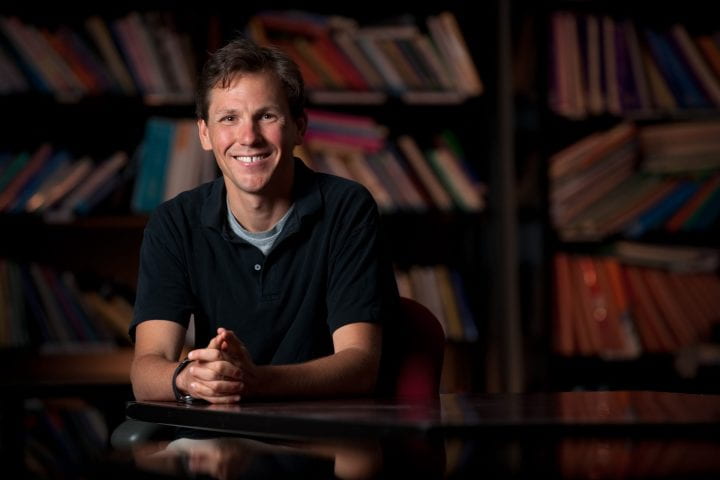Equal opportunity educator
Thad Domina, assistant professor of education, traces the road from high school to college and beyond.

It’s an oft-repeated question as the economy tanks: Is college a worthy investment? Open any newspaper and you’ll find a cautionary tale about a bright, recent college graduate working at McDonald’s to repay student loans. Sensational headlines grab readers’ attention but don’t tell the full story, says Thad Domina, assistant professor of education at UC Irvine.
“These articles rarely ask what happens 10 or 20 years down the road,” he says. “A college graduate is likely to transition from flipping burgers to running a think tank or working as a high school principal.”
According to the College Board, a nonprofit advocacy group, the median salary of college graduates in 2008 was $55,700, which was $21,900 more than the median salary of high school graduates who hadn’t attended college.
In his research, Domina addresses myths about the American education system. His focus is college access and the transition from high school to postsecondary institutions. A common misperception in California is that high schools promote mediocrity. In fact, Domina says, they have greater expectations than ever.
“The state high school exit exam and course requirements for college entry have raised the bar on high school students,” he says, adding that teens also set high standards for themselves.
Nationally, 85 percent of seniors said that obtaining a bachelor’s degree was an educational goal. According to Domina, only 45 percent of high school sophomores in 1982 expected to attend college.
The broadening of scholastic opportunities was central to the United States’ evolution into a global power, he says, and policymakers shouldn’t lose sight of the importance of investing in education for all.
“Education drives innovation and social mobility, and the rest of the world has caught on,” Domina says. “Some people see the rise of Western Europe and Asia and conclude that American education is in decline, but the story is more subtle.”
Social inequalities, he notes, have a great impact on student success. Teachers and school districts, despite their best efforts, can be powerless when faced with the challenges of educating children from poor, unstable families.
“American education is not in decline, but it needs to get better for disadvantaged students,” Domina says. “We’re learning that what happens outside school matters so much. It’s not fair to expect schools to educate students and fix social problems.”
He himself is an example of education’s power to alter lives. A native of Norfolk, Neb., Domina attended Wesleyan University, in Connecticut, followed by graduate school at the City University of New York, where he earned a Ph.D. in sociology.
“For many people, college is a great tool for social mobility,” Domina says. “I wasn’t the first in my family to go to college, but I was the first to leave the state to do so. It certainly changed my social milieu.”
An education writer in New York before transitioning to academia, he was a reporter at University Business, a magazine for college administrators, and wrote and edited for several publications covering politics, business, and academic life.
In 2007, Domina joined UCI. Teaching students research skills and data interpretation is among the most important aspects of his job, he says: “Numbers have a way of scaring people. But numbers are very powerful, and the person who is not scared of them is in a position to help others.”
Domina was recognized at UCI’s 18th annual Celebration of Teaching in May for “excellence in undergraduate teaching.” His efforts to revamp the gateway course to an education minor were applauded by department chair Deborah Lowe Vandell.
He modernized the curriculum by focusing on current issues in education reform, including the controversial No Child Left Behind Act. Domina and colleagues boosted the course’s rigor by adding regular writing assignments, research projects and group presentations. Enrollment has grown from 40 students per class to nearly 70, and evaluations remain high, says Vandell.
Domina estimates that two-thirds of education undergraduates go on to careers as K-12 teachers, entering a system that demands more and more of instructors and students.
“Twenty years ago, college prep was only for elite students,” he says. “Today, teens start taking algebra in eighth grade, and a greater number are opting for Advanced Placement courses.”
Vocational education is also increasingly rigorous, Domina says: “About a third of high school students take vocational classes in health services and computer sciences, which require advanced math and critical thinking skills.”
The K-12 goal, he notes, should be to provide students with the tools and resources to pursue postsecondary education of their choice, whether through vocational programs, community colleges or research universities.
“The pipeline from high school to college needs to be made less leaky,” Domina says, “so that all students are able to succeed postgraduation.”


